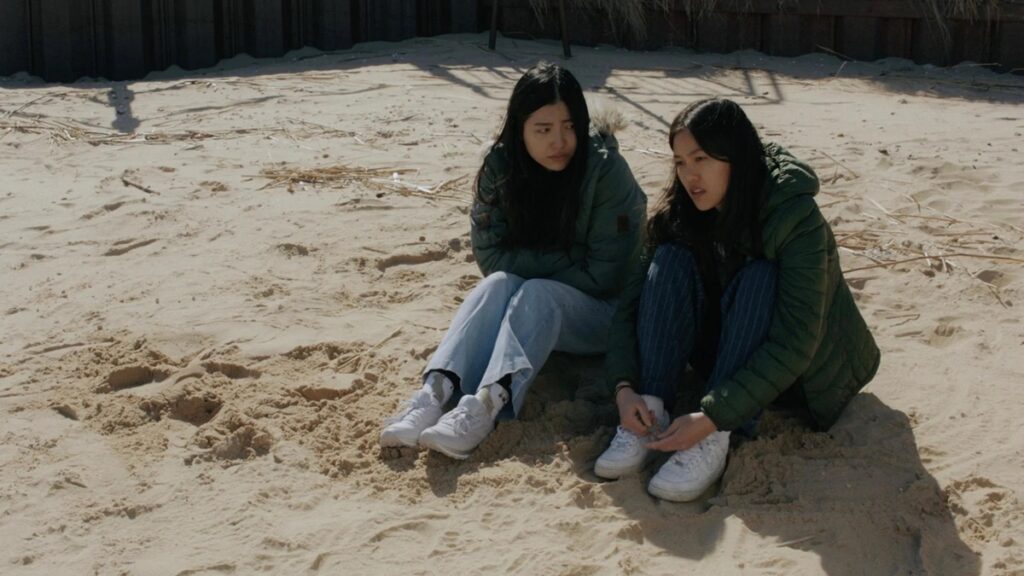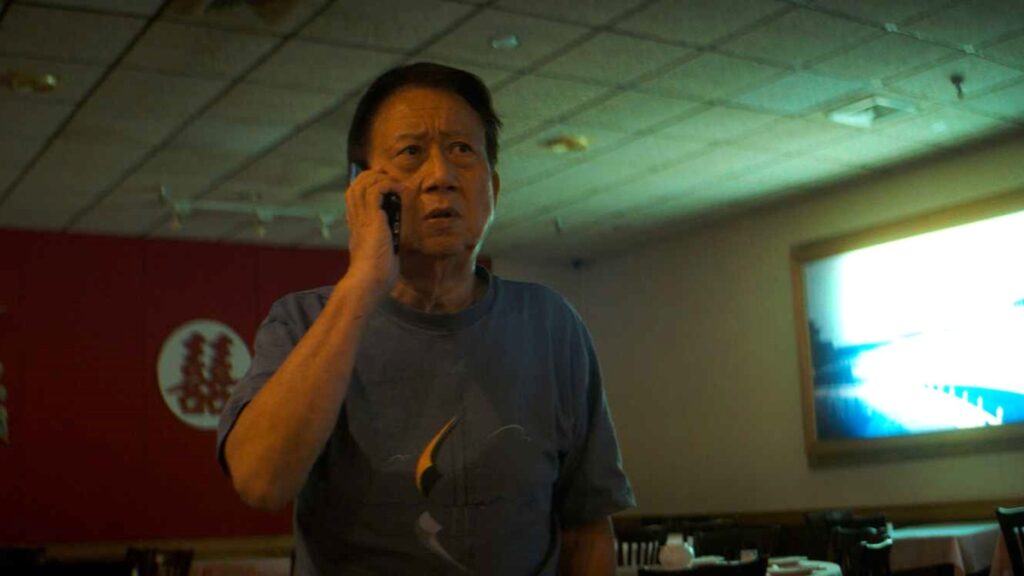Taking a look at the offerings of Slamdance, Park City’s more indie-minded festival.
Initially developed in 1995 as an alternative to the more polished version of independent cinema presented at Sundance, the Slamdance Film Festival has evolved over the past 28 years. These days, with a few exceptions, most of Slamdance’s slate could easily compete with those films chosen for that other festival. In fact, several proved better made and more interesting than much of Sundance’s selections.
This year’s winner of the Slamdance Grand Jury Prize for Best Narrative Feature, Linh Tran’s Waiting for the Light to Change, proved entirely worthy of the accolades. Set at a lake house in Michigan during winter’s last gasp, the film centers on a getaway trip gone wrong. For high school sweethearts Jay (Sam Straley) and Kim (Joyce Ha), the occasion is a chance to reunite with their friend Amy (Jin Park) after she’s been several hundred miles away in California working on her Masters. Jay’s stepbrother Alex (Erik Barrientos) and Kim’s cousin from China, Lin (Qun Chi), round out the quintet.
A combination of the weather and a boring nearby town reduce the group’s activities to either taking long walks on the chilly shore or huddling up inside. Soon both prove fertile ground for various emotional conflicts. Alex is clearly attracted to Amy, but she has feelings for Jay that date back to high school. The reunion and her improved confidence reawaken those desires. Lin is the only one who seems spared this maelstrom of feelings, unrequited and otherwise. She mostly seems just happy to be there.

Given the genre and its tropes, audience hesitance is understandable. Many, especially on the festival circuit, have been burned by single-location films populated by 20-somethings wrestling with quarter-life crises via mostly improvised dialogue. However, that instinct would be a mistake as Waiting for the Light to Change proves unusually impressive in practice. Visually, the film benefits from the precision of long takes favored by Tran and cinematographer David Foy. First, they help establish the emotional status of the relationships. Then they help chart how those dynamics shift over the course of the week.
Tran also uses a similarly restrained approach to her work with the actors, ensuring their performances never cross into overt melodrama. In turn, the actors all do well establishing the feelings and regrets of their characters subtly and organically. Unfortunately, that hushed quality does, occasionally, become literal. There are a few points where they become difficult to hear.
Waiting for the Light to Change is the kind of movie that might well have gone on to be a sleeper hit back in the American indie film scene’s era of thriving. Sadly given it lacks a title that jumps off the page, easily exploitable elements, or an overly flashy style, there’s a good chance it’ll go overlooked. That would be a shame. It is an intelligent, incisive debut that has me eager to see what Tran makes next.

Over on the documentary side of things, Law Chen’s equally impressive Starring Jerry As Himself scored big, taking home the Grand Jury and Audience Award prizes. As the film opens, Jerry Hsu, a divorced Taiwanese immigrant living in Orlando, gathers his family to recount an astonishing story. Much of the ensuing film is a dramatic reenactment of his tale, blurring the line between documentary and narrative filmmaking. And it all stars Jerry, as himself, of course.
As the tale goes, one day, he receives a bizarre phone call from T-Mobile in China informing him that his phone is about to be shut down. The person on the other end explains the action stems from Jerry using his phone to speak out against the government. He’s been discovered, and a warrant issued for his arrest.
Since Jerry had not been in China for decades and certainly didn’t have a phone registered there, he assumes he’s the victim of identity theft. So he contacts the Chinese Security Bureau to plead his case. They agree he’s most likely innocent, but spot another issue. The likely perpetrator seems to be a wanted criminal who’s also laundering millions through Jerry’s bank in Florida. So the Bureau asks him to help investigate this to establish his innocence fully. Jerry, eager to prove his innocence, follows their directives.
Before long, he finds himself bonding with the voices on the other end of the phone. Unable to tell anyone in his life about the case, these long-distance individuals become his support network. Meanwhile, his local loved ones begin noticing Jerry’s behavior growing increasingly unusual. I’ll not disclose where it goes from there, though I suspect many will guess.

What makes the film work so well is how Chen tells it. Instead of a straightforward documentary treatment with the usual array of talking heads, it blends documentary and narrative styles. That choice proves surprisingly invigorating. In addition, by using dramatic reenactments, the film goes deeper into Jerry’s mindset, making his decisions easier for the audience to understand.
Simultaneously, the reenactments underline the question posed at the film’s start, “What is a true story?”. In this case, viewers find themselves wrestling with Jerry’s reliability as a narrator and the story’s veracity, as a result. That sensation is further amplified by Hsu’s (who also won an award from the festival for his performance) credit as co-scriptwriter with Chen.
While brief, Starring Jerry as Himself packs a lot in. It proves both a fascinating story and a challenge to interrogate how film captures reality. Moreover, it asks how narratives can be shaped and changed depending on who recounts the story. The result is a bracing mind-bender that will likely challenge your beliefs on the topic.

Although it is a straightforward narrative Quark Henares’ Where is the Lie? makes an intriguing companion piece to Starring Jerry as Himself. Using a viral Twitter thread as its foundation, the doc also interrogates the nature of truth.
Where is the Lie? tells the story of Janzen Torres (EJ Jallorina), a trans woman stuck in a romantic rut. When she matches with Theo (Royce Cabrera), things start to look up. She almost immediately falls for him, despite her friends’ gentle warnings. Seems Jazen has a tendency to move too fast regarding matters of the heart. To their credit, history does seem to be repeating itself after Theo ghosts her the day they’re first supposed to meet. Janzen is determined to find out what happened. The quest takes her down a rabbit hole that is horrifying and enraging in equal measure. Things really take a turn when a third participant, a filmmaker named Beanie Landridos (Maris Racal), joins the tale.
As one can probably surmise, this is a largely heartbreaking story, but Henares presents it more like a dark comedy. It’s an approach that does yield some big, if discomfiting, laughs. Unfortunately, it also results in occasional awkward tonal shifts.
For the most part, Where is the Lie? is an engaging work, thanks in large part to Jallorina’s performance. It offers an intriguing exploration of the pitfalls that can occur when people lay their hearts on the line to others and why they’ll continue to despite obvious red flags.

There were more traditional documentaries on display at Slamdance this year as well. Bearing the obvious influence of the classic Streetwise, Elisa Levine and Gabriel Miller’s startling and often-heartbreaking Sweetheart Deal utilizes the classic cinema verite approach to follow four Seattle sex workers—Kristine, Krista, Sara, and Tammy—as they attempt to get clean. Aiding in their endeavors is Elliott, a self-proclaimed Good Samaritan. He provides much-needed food, shelter, and a place to detox in the form of his RV. While the recovery process is fraught in any number of predictable ways, there is a development that none of them could possibly see coming. It proves to have a devastating effect on them.
On a more optimistic note, Elsbeth Fraanje’s Sexual Healing follows Evelien, a 53-year-old disabled woman taking sexual intimacy matters into her own hands. As she goes on her journey, including stops at a store for sexual paraphernalia and a meeting with a sex worker, both she and the film grapple with notions of desire, intimacy, and expectations in an ultimately hopeful and inspiring manner.
Perhaps the most traditional of the bunch is The Art of Silence, a straightforward look at the life and legacy of renowned mime Marcel Marceau. It contains some fascinating archival material of Marceau at work but is otherwise undistinguished.

On the narrative side, Jeff Ruthergord’s debut feature, A Perfect Day for Caribou, is a grim exploration of intergenerational trauma. Many may find it too much of a depressing chore to sit through. However, those who stick it out will be rewarded with good performances from Jeb Berrier, Charlie Plummer, and Oellis Levine as the three generations at the heart of the tale. The film also boasts some striking b&w photography and Academy ratio framing from cinematographer Alfonso Herrera Salcedo. So while the results may be bleak, they are still worth checking out.
That’s more than I can say for Love Dump, Jason Avezzano and Matt Mahaffey’s Chicago-lensed spoof of Hallmark romance movies and their absurd tropes. Focused on an on-again, off-again romance between a trash refurbisher (Leila Gorstein) and a dog lawyer (Jesse Kendall), it feels like watching someone shooting at fish in a barrel and somehow still managing to miss. Despite only clocking in at 50 minutes, the whole thing feels interminable.
Things got somewhat weirder with Matt Kiel’s Unicorn Boy, an animated film. It’ll no doubt garner attention thanks to the likes of Patton Oswalt and Maria Bamford in the voice cast. The story revolves around depressed artist Matt (Kiel). Reeling from a recent breakup he initiated, he lands in a magical land populated by rainbow-vomiting unicorns. Soon everything there proves to symbolize Matt’s long-standing relationship issues. Although occasionally striking on a visual level, Matt proves a deeply uninteresting and self-pitying protagonist. Most viewers will run out of patience with him and the film long before it ends.

Those looking for a shot of pure strangeness were better off with Mad Cats, an endearingly loopy Japanese import from writer-director Reiki Tsuno. Take (Sho Mineo) is a young man at odds with life since his brother’s mysterious disappearance. One day, he receives a tape from a woman telling him how to find his brother. It sets him off on a journey that finds him encountering all manner of strangeness. For instance, he battles a group of cats transformed into cunning and deadly women with a box of magical catnip.
Yes, this is all pretty silly, but Tsuno invests it with a lot of lunatic energy that moves things along. Nonetheless, the obviously low budget and a certain repetitiveness to the material set in after a while. Although probably best experienced at midnight with some form of chemical enhancement, Mad Cats is fun regardless of your state. Either way, you may look a little funny at the next cat that crosses your path.